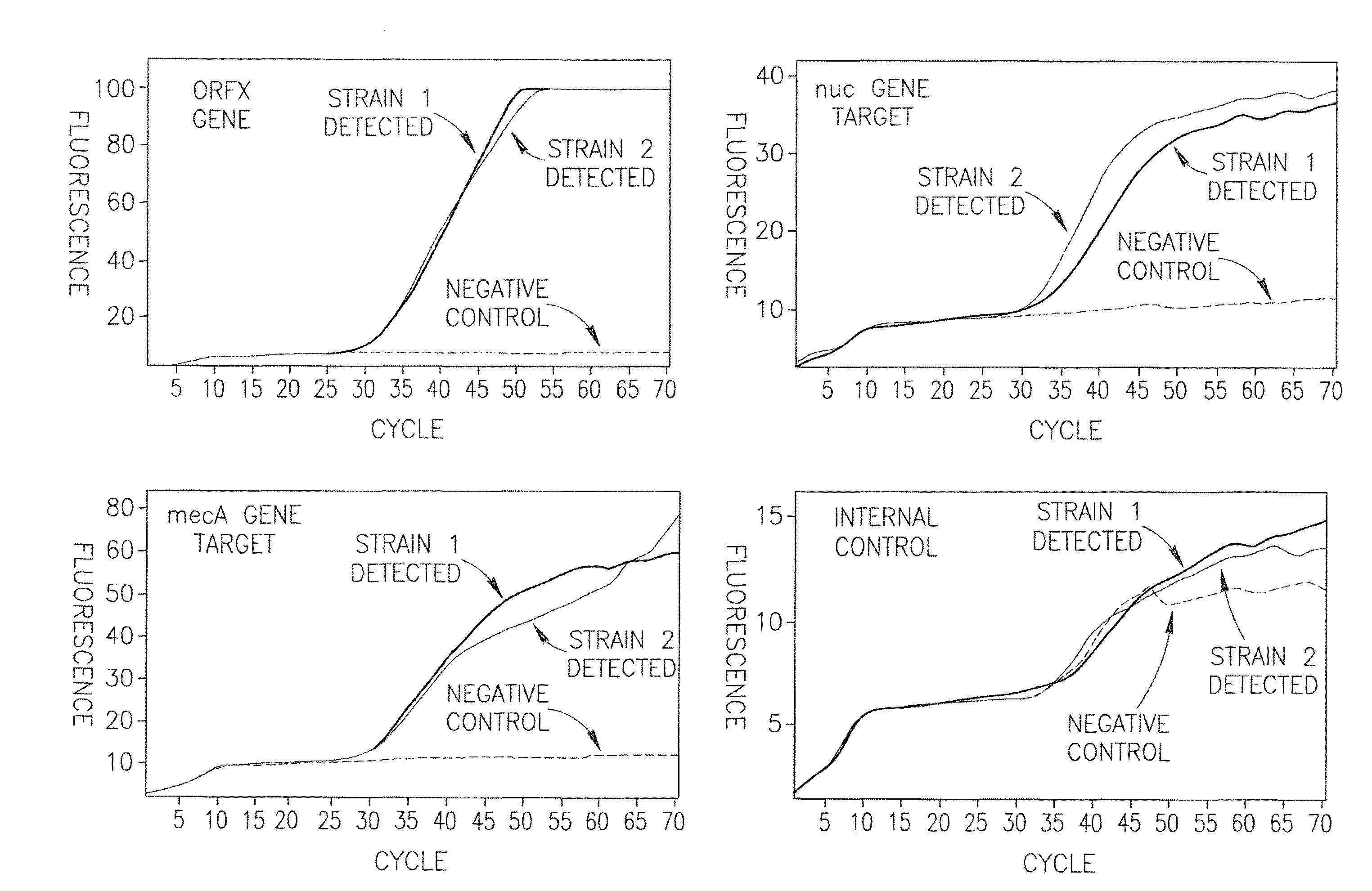Methods and compositions for multiplex PCR amplifications
a technology amplification, applied in the field of polymerase chain reaction (pcr) mixtures, can solve the problems of increasing the likelihood of non-specific hybridization, reducing sensitivity and data quality, and exacerbated problems, so as to reduce the efficiency of pcr, reduce cost and complexity, and accelerate the obtaining of test results.
- Summary
- Abstract
- Description
- Claims
- Application Information
AI Technical Summary
Benefits of technology
Problems solved by technology
Method used
Image
Examples
example 1
Multiplex PCR Using Hot-Start Primers May Exhibit Amplification Difficulties Under Certain Conditions
Material and Experimental Methods
Probes and Primers for Example 1
Probes
[0164]Four dual-labeled Molecular Beacon probes were used, as depicted in Table 1; one complementary to the S. aureus orfX region (SEQ ID NO: 1), a second complementary to the S. aureus-specific nuc gene (SEQ ID NO: 2), a third complementary to the mecA gene (SEQ ID NO: 3), and a fourth complementary to the internal control DNA (SEQ ID NO: 4).
TABLE 1Dual-labeled Molecular Beacon probes.5′-end3′-endConcentration inSEQ IDSequenceFluorophoreQuencherreaction mixture1cgcgatctcgtcattggcggatc6-FAMBHQ-10.5 micromolaraaacggcctgcacgatcgcg(green)2cgcgatcttggttgatacacctgROXBHQ-20.5 micromolaraaacaaagcatcctgatcgcg(orange)3cgcgatcctgattcaggttacggHEXBHQ-10.5 micromolaracaaggtgatcgcg(yellow)4cgcgatcccaggaagacaggtQuasar 670BHQ-20.5 micromolaracaggatcattctgcgatcgcg(red)
[0165]Dual-labeled Molecular Beacon Probes were purchased from ...
example 2
Clinical Nasal Swab Samples May Inhibit PCR Using Hot-Start Primers
Preparation of the First Sample Type (“Spiked Nasal Sample”)
[0178]1. A monodisperse solution was prepared from each bacterial strain in TE pH 8.3, using the Detect-Ready™ MRSA Lysis Kit as follows:[0179]a. A single colony was picked with a sterile bacteriological loop and shaken into 1 ml TE pH 8.3 Buffer.[0180]b. Dilutions were made to reach a concentration of 104 cfu per ml, by transferring 100 μl into 900 μl of TE (Tris-EDTA), then mixing and repeating this step two additional times.[0181]2. With a sterile pipette tip, 10 μl of the diluted bacterial colony (equivalent ˜300 cfu) was removed and spiked onto a saline-moistened nasal swab that was swabbed inside a nostril of a human volunteer.[0182]3. A Prep Tube was opened and the swab inserted until the head of the swab was fully submerged in the Sample Preparation Buffer solution.[0183]4. The swab was agitated in the buffer for 10-15 seconds (vi...
example 3
A Nested Combination of Hot-Start Primers and Regular Primers Overcomes Inhibition of qPCR by Nasal Swab Samples
Primers
[0199]The non-hot-start forward and reverse primers used in Example 3 are depicted in Table 3 and are described below.
SEQ ID / Concentration inidentitySequencereaction mixtureSEQ ID No: 18CGCATGACCCAAGGG0.05micromolarorfX forwardCASEQ ID No: 19ATTTCATATATGTAA0.05micromolarSCCmec revTTCCTCCACATCTCSEQ ID No: 20GTCAAAAATCATGAA0.05micromolarSCCmec revCCTCATTACTTATGSEQ ID No: 21CTCTGCTTTATATTA0.05micromolarSCCmcc revTAAAATTACGGCTGSEQ ID No: 22CACTTTTTATTCTTC0.05micromolarSCCmec revAAAGATTTGAGCSEQ ID No: 23TGGAAATCCATCTCT0.05micromolarSCCmec revACTTTATTGTTTSEQ ID No: 24TCCATCTCTACTTTA0.05micromolarSCCmec revTTGTTTTCTTCAASEQ ID No: 25AAGCGATTGATGGTG0.035micromolarnuc forATACGSEQ ID No: 26AAATGCACTTGCTTC0.035micromolarnuc revAGGACSEQ ID No: 27GGTGAAGATATACCA0.035micromolarmecA forAGTGATTASEQ ID No: 28GTGAGGTGCGTTAAT0.035micromolarmecA revATTGC
Experimental ...
PUM
| Property | Measurement | Unit |
|---|---|---|
| Composition | aaaaa | aaaaa |
| Ratio | aaaaa | aaaaa |
| Thermal stability | aaaaa | aaaaa |
Abstract
Description
Claims
Application Information
 Login to View More
Login to View More - R&D
- Intellectual Property
- Life Sciences
- Materials
- Tech Scout
- Unparalleled Data Quality
- Higher Quality Content
- 60% Fewer Hallucinations
Browse by: Latest US Patents, China's latest patents, Technical Efficacy Thesaurus, Application Domain, Technology Topic, Popular Technical Reports.
© 2025 PatSnap. All rights reserved.Legal|Privacy policy|Modern Slavery Act Transparency Statement|Sitemap|About US| Contact US: help@patsnap.com



